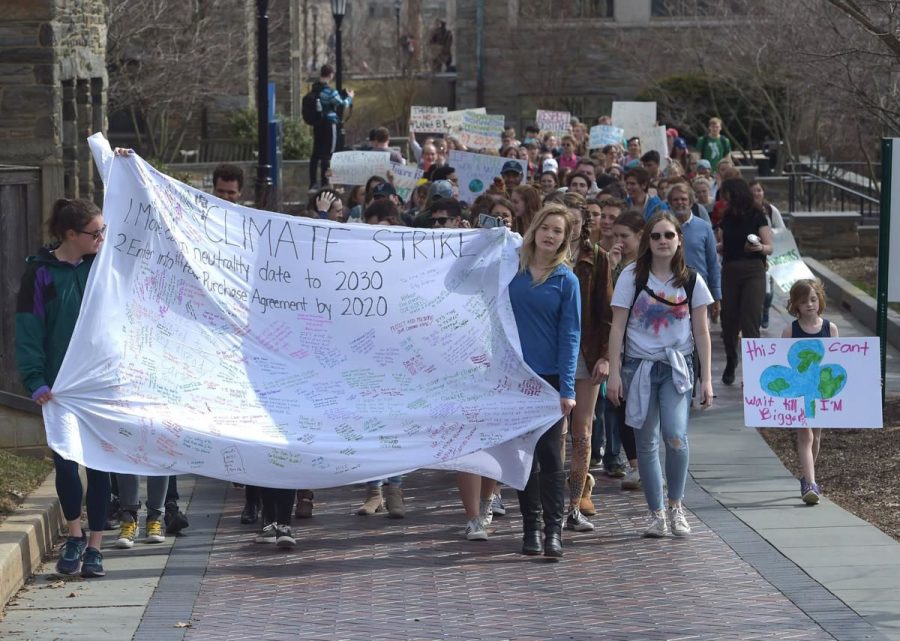Climate Walkout: A Renewably Energizing Step in the Right Direction
March 19, 2019
Despite forecasts for rain, this past Friday was easily the most beautiful day of the year so far, with clear blue skies and temperatures soaring past seventy degrees. For the steadily-growing cluster of people at the Riley Ellipse, the weather felt particularly fortuitous. Students, professors, community members and their enthusiastic children had all set aside time from their busy schedules to hold Villanova accountable for advancing campus sustainability goals, and it felt almost as if Mother Nature were lending her seal of approval.
The goals of the University’s first Climate Walk-Out were concrete and firm: protestors wish to see the campus entirely carbon neutral by 2030, rather than Father Peter’s initial promised date of 2050, and to turn over campus energy to entirely renewable sources by next school year. These goals are specific to Villanova’s campus, but—like the anticipated impacts of emission cutbacks—the movement itself has a global magnitude.
The symbolic “School Strikes for Climate” were started by sixteen-year-old Greta Thunberg in Sweden last summer, and have built steady momentum through this past winter. The Villanova students who participated yesterday joined Thunberg for her 30th straight week of striking, along with peers from 125 countries and all seven continents. For months, Thunberg’s earnest speeches and defiant protests have served as a reminder of the power students possess to affect change. Though younger than any student at our university, she has sparked a global political movement, appeared before the UN’s Intergovernmental Panel on Climate Change and earned a nomination for the Nobel Peace Prize for her incredible efforts. Students have turned out in the millions to support Greta’s message and to assert their demand for institutional change and environmental protection.
There are thousands of places hosting a School Strike for Climate, and it is incredibly encouraging to see Villanova among them. Elite universities hold a unique power for political change, because on our campus holds a concentration of thousands of people with the passion to call for justice and the intelligence to flesh out its intricacies. Villanova, and universities like it, serve as an incubator for the minds that will shape our future: the engineers who will create viable solutions, the scientists who will determine our progress, the corporate leaders who can make ethical change to industry’s staggering contributions, the politicians who will shape legislation and many, many more. By prioritizing our campus’s sustainability and contributions to climate change, Villanova students can step into these leadership roles before graduation—because unfortunately, our global climate crisis will not “hold off” until we each have a diploma in hand.
Further, it would be disingenuous not to acknowledge the privilege and power imbalance at play in the university selection process (particularly given recent events). Unfortunately, it is undeniable that class status plays a significant role in many students’ path to college, and many of Villanova’s students enjoy this opportunity to advance themselves and their world through education due in part to institutionalized privilege and wealth.
Scientists have proven that many of the initial dangers of climate change—those our planet has suffered already, and those that lie ahead—will disproportionately impact citizens without these same financial resources. Struggling households, neighborhoods and even whole countries will feel the effects of climate change before the affluent individuals who had the means to contribute to the problem.
All of this is to say that while climate change may not have immediacy to Villanova or its students as a threat, it does present our students with an immediate responsibility. Here, we have access to the knowledge, the resources and the community to grant us efficacy, and it therefore falls to us to put them to good use. Student speakers at Villanova’s walk-out made the prudent point that our peer universities have already acknowledged this responsibility and put themselves to the task—American University has already achieved carbon neutrality, and Georgetown has plans to cut their emissions in half by next year.
The climate walk-out was filled with hope for a better campus and a better future, and in looking around at my fellow students—who prioritized their responsibility to our planet, and each other, over tests or GPAs—I knew that real change was finally within our grasp.











